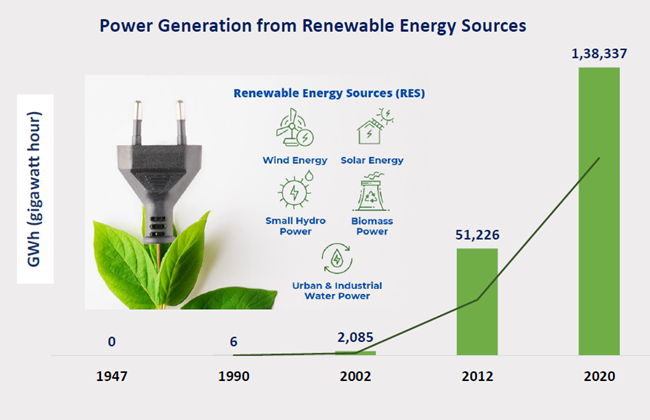Others
Renewable Energy in India
Posted On: 09 SEP 2022 3:20PM
Renewable Energy in India
With a population of 1.3 billion, India has a massive demand for energy to fuel its rapidly growing economy. From a power deficit nation at the time of Independence, the efforts to make India energy-independent have continued for over seven decades. Today, we are a power surplus nation with a total installed electricity capacity of over Four lakh MW.
Keeping in mind the sustainable development goals, India's power generation mix is rapidly shifting towards a more significant share of renewable energy. Today, India is the world's third largest producer of renewable energy, with 40% of its installed electricity capacity coming from non-fossil fuel sources.
The Journey towards Renewable Energy in India
As a developing nation at the time of Independence, India relied heavily on coal to meet its energy demands. However, India has always been committed to looking for more alternative energy sources for sustainable development. The beginning was made with hydropower, with major hydroelectric power projects appearing on the scene of India’s energy arena. Over the years, many policy and regulatory initiatives have promoted hydropower development and facilitated investments. Today, we are 5th in the world regarding usable hydropower potential.
Bhabha Atomic Research Centre (BARC) was founded in the 1950s to secure the country's long-term energy independence. Today, we are the only developing nation with indigenously developed, demonstrated and deployed nuclear reactors for electricity generation. This was made possible through several decades of extensive scientific research and technology development.
Work on wind energy started in India during the 1960s when the National Aeronautical Laboratory (NAL) developed windmills, primarily for supplying irrigation water. Today, we have the 4th largest wind power capacity in the world, blessed with a constant movement of wind, especially in the Southern, Western and North Western regions.
Solar energy-based applications have benefited millions of Indians by meeting their cooking, lighting and other energy needs in an environment-friendly manner. Having achieved large-scale success in solar energy solutions, India has spearheaded the International Solar Alliance (ISA) which is an action-oriented, member-driven, collaborative platform for increased deployment of solar energy technologies. The membership of the ISA is open to all member-states of the United Nations, and 107 countries are signatories to the ISA Framework Agreement at present. The Alliance aims to efficiently utilise solar energy to reduce fossil fuel dependence, thereby creating a greener planet.
Biomass has also been an essential source of energy for India. It is renewable, widely available, carbon-neutral and has the potential to provide significant employment in rural areas. Rapidly evolving technology has enabled thermal power plants to have more economical and energy-efficient operations. India has co-fired biomass in thermal plants across the country to reduce its CO2 footprint in thermal power generation. biomass power/co-generation programme since mid-nineties. Over 800 biomass power and bagasse/non-bagasse cogeneration projects have been installed in the country for feeding power to the grid.

Promoting Clean Energy and Climate Change
India has progressively decoupled economic growth from greenhouse gas emissions. For example, the Net Zero Emissions target by 2030 by Indian Railways alone will reduce emissions by 60 million tonnes annually. Similarly, India's massive UJALA LED bulb campaign is reducing emissions by 40 million tonnes annually. To further complement these ongoing efforts, India launched the National Hydrogen Mission in 2013 to make India the world's largest hydrogen hub.
Even though it supports the second largest population in the world, India’s sustained efforts have ensured that its per capita CO2 emissions are much lower than the global average. The US emits 14.7 tonnes per capita, China emits 7.6 tonnes per capita, while India’s CO2 emissions amount to 1.8 tonnes per capita.
The global power sector is undergoing an accelerated transformation due to technological innovations and response to climate change protocols. At COP-21 in Paris in 2015, India committed to a 40% share of power generation from non-fossil fuel sources. We have achieved this target a decade ahead of the 2030 timeline.
India has always shown its willingness in leadership to fight climate change. The country’s vision is to achieve Net Zero Emissions by 2070, in addition to attaining the short-term targets which include:
- Increasing renewables capacity to 500 GW by 2030,
- Meeting 50% of energy requirements from renewables,
- Reducing cumulative emissions by one billion tonnes by 2030, and
- Reducing emissions intensity of India’s gross domestic product (GDP) by 45% by 2030.
India's experience will be valuable to other developing nations as they translate their climate pledges into actions and undertake energy transitions towards a more sustainable energy future.
*****
AG/HP/RC/MZ
(Features ID: 151141)
आगंतुक पटल : 1133
Provide suggestions / comments